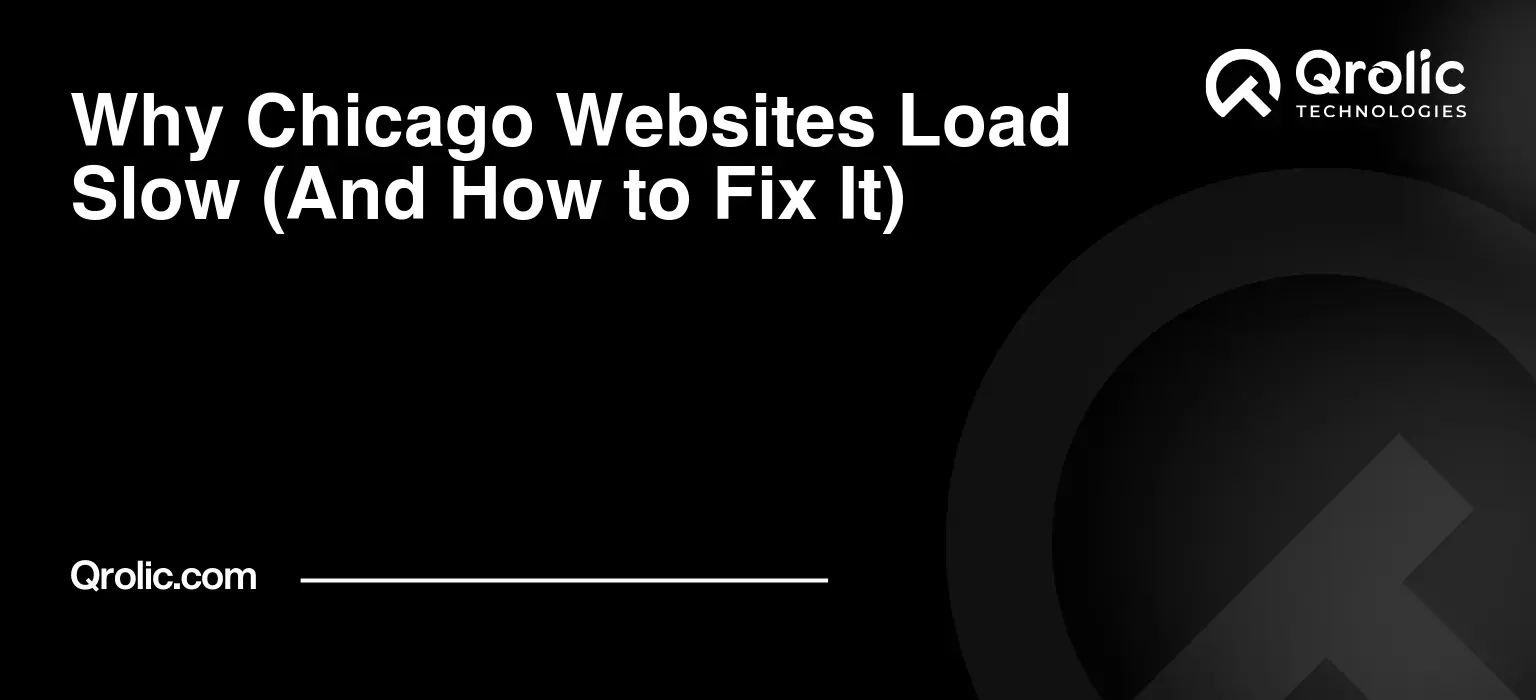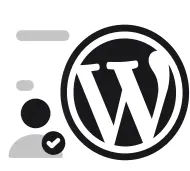Imagine you’re standing on Michigan Avenue, ready to catch a cab, but every single vehicle moves at a snail’s pace, stuck in perpetual gridlock. Frustrating, right? Now, picture that same infuriating wait, but it’s happening every time a potential customer tries to access your Chicago business’s website. They click, they wait, and after a few agonizing seconds, they give up and hail a competitor’s digital ride. This isn’t just a hypothetical scenario; it’s the digital reality for far too many businesses in the Windy City.
In a city that prides itself on its swift, deep-dish pizza delivery and the efficient flow of its iconic river, the sluggish performance of local websites is an unacceptable paradox. Whether you’re a bustling Loop law firm, a charming Wicker Park boutique, or a beloved Lincoln Park restaurant, a slow-loading website isn’t just an inconvenience; it’s a digital anchor dragging down your entire operation. It impacts everything from customer satisfaction to search engine rankings and, ultimately, your bottom line. Let’s peel back the layers of this digital mystery, uncover the common culprits behind slow Chicago websites, and, more importantly, lay out the definitive blueprint for supercharging your online presence.
Quick Summary:
- Slow websites lose customers and lower Google rankings.
- Common causes are bad hosting, huge images, and messy code.
- Fix it with better hosting, image optimizing, and website caching.
- Experts like Qrolic can help with complex speed problems.
Table of Contents
- The Frustrating Reality: Why Speed Matters More Than Ever for Chicago Businesses
- The “Chicago Minute” – Why Slow is Unacceptable
- Impact on User Experience (UX): From Delight to Disappointment
- Impact on SEO Rankings: Google’s Preference for Speed
- Impact on Conversions and Revenue: Lost Sales, Missed Leads
- Diagnosing the Digital Drag: Common Culprits Behind Slow Chicago Websites
- Overloaded Servers & Subpar Hosting (Especially for Local Providers)
- Unoptimized Images: The Digital Deep-Dish Dilemma
- Bloated Code & JavaScript Overload: The Loop’s Digital Gridlock
- Database Blues: When Your Data Gets Lost in the Labyrinth
- Third-Party Script Overload: The Digital Tourist Trap
- Lack of Caching: Rebuilding the Willis Tower Every Time
- Mobile Responsiveness Woes: Navigating the Streets of Chicago on a Flip Phone
- Geographic Distance to Servers: Is Your Server Visiting Wrigleyville from Afar?
- The Blueprint for Speed: Actionable Strategies to Supercharge Your Chicago Website
- Invest in High-Quality, Geographically Relevant Hosting
- Master Image Optimization: Sharpening Your Digital Skyline
- Declutter Your Code and Streamline Scripts: Clearing the Digital Expressway
- Optimize Your Database: Keeping Your Data Flowing Like the Chicago River
- Implement Robust Caching Strategies: Building a Digital Express Lane
- Leverage a Content Delivery Network (CDN): Bringing Wrigleyville Closer to Everyone
- Prioritize Mobile-First Design: Your Website, Ready for the CTA Train
- Reduce Third-Party Dependency Bloat: Don’t Let Digital Tourists Slow You Down
- Regular Performance Monitoring & Auditing: Your Website’s Annual Check-Up
- The Benefits of a Blazing-Fast Chicago Website: More Than Just Bragging Rights
- Enhanced User Experience (UX): Happy Visitors, Lower Bounce Rates
- Improved SEO Rankings: Google Rewards Speed
- Higher Conversion Rates: More Leads, Sales, Bookings
- Increased Brand Credibility: Professionalism, Reliability
- Future-Proofing: Staying Ahead of Competitors
- When to Call in the Experts: Your Chicago Website’s Performance Pit Crew
- When DIY Isn’t Enough
- Complex Issues Requiring Specialized Knowledge
- Saving Time and Resources
- Qrolic Technologies: Your Partner in Chicago Website Speed Optimization
- Final Thoughts: Building a Faster Digital Chicago for Tomorrow
The Frustrating Reality: Why Speed Matters More Than Ever for Chicago Businesses
In the fast-paced rhythm of Chicago life, time is a commodity more precious than a front-row seat at Wrigley Field. Chicagoans expect efficiency, clarity, and instant gratification, whether they’re navigating the CTA or browsing for services online. When your website lags, it doesn’t just annoy; it actively repels.
The “Chicago Minute” – Why Slow is Unacceptable
We live in an age of instant gratification. A “Chicago minute” used to mean “a little while,” but in the digital realm, it’s shrunk to milliseconds. Research consistently shows that most users expect a website to load within 2-3 seconds. Beyond that threshold, bounce rates—the percentage of visitors who leave your site after viewing only one page—skyrocket. For Chicago businesses, this means potential customers looking for that perfect deep-dish, a reliable plumber, or a last-minute theater ticket are simply moving on to a faster competitor. Every second of delay compounds the frustration, turning a potential client into a lost opportunity.
Impact on User Experience (UX): From Delight to Disappointment
A slow website is akin to a restaurant with excellent food but excruciatingly slow service. No matter how good your content, products, or services are, if the user can’t access them quickly and smoothly, their experience is tarnished. A poor user experience leads to negative perceptions of your brand. In Chicago, where word-of-mouth still holds significant weight, a reputation for a sluggish website can spread faster than news of a Cubs win. Visitors associate slow loading with unprofessionalism, outdated technology, or a general lack of care, directly undermining your brand’s credibility.
Impact on SEO Rankings: Google’s Preference for Speed
Think of Google as the ultimate traffic controller for the internet. Just like city planners want smooth traffic flow, Google wants to provide its users with the fastest, most relevant results. For years, Google has explicitly stated that page speed is a significant ranking factor, particularly for mobile searches. This means that if your Chicago website loads slowly, it’s not just a minor annoyance; it’s actively being penalized in search engine results pages (SERPs). Your competitors with faster sites will outrank you, siphoning away valuable organic traffic. In a competitive market like Chicago, appearing higher in Google search results for terms like “best pizza Chicago” or “Chicago real estate agent” can be the difference between thriving and merely surviving.
Impact on Conversions and Revenue: Lost Sales, Missed Leads
The ultimate goal of most business websites is conversion—whether it’s making a sale, generating a lead, securing a booking, or simply getting a phone call. Every fraction of a second added to your load time chips away at your conversion rate. An e-commerce site selling Chicago-themed apparel might see abandoned shopping carts if the checkout process is slow. A professional service firm might lose potential clients who can’t quickly access their contact forms. Businesses selling tickets for a Chicago theater production might find patrons abandoning the purchase if the payment gateway is sluggish. The cumulative effect of these lost opportunities can translate into significant revenue shortfalls. A fast website is an investment that pays dividends, directly contributing to your business’s growth and profitability in the competitive Chicago landscape.
Diagnosing the Digital Drag: Common Culprits Behind Slow Chicago Websites
Just as a mechanic needs to diagnose engine trouble, we need to pinpoint the specific issues throttling your Chicago website’s speed. Many local businesses, often focused on their core operations, unknowingly harbor these digital performance vampires. Understanding these common culprits is the first step toward reclaiming your website’s velocity.
Overloaded Servers & Subpar Hosting (Especially for Local Providers)
This is perhaps the most fundamental and frequently overlooked problem. Many Chicago small businesses, seeking cost-effectiveness, opt for shared hosting plans. While affordable, shared hosting means your website shares server resources (CPU, RAM, bandwidth) with dozens, even hundreds, of other websites. If one or more of these neighbors experience a traffic surge or have poorly optimized code, your site’s performance takes a hit—it’s like trying to drive on Lake Shore Drive during rush hour. Furthermore, choosing a hosting provider with servers located far from Chicago can add latency, making every data request travel further. Some local providers might offer what seems like a good deal but lack the infrastructure or expertise to deliver consistent, high-speed performance.
Unoptimized Images: The Digital Deep-Dish Dilemma
Chicago is a city of stunning visuals – from the architectural marvels of the skyline to the mouth-watering allure of its culinary scene. Businesses naturally want to showcase these visually captivating elements on their websites. However, large, unoptimized images are one of the biggest culprits for slow load times. High-resolution photos taken directly from a camera, not properly compressed or resized, can be several megabytes in size. Loading multiple such images on a single page is like trying to squeeze a whole deep-dish pizza through a tiny window – it’s going to take a long, long time. Many sites also fail to implement “lazy loading,” where images only load as the user scrolls down, further exacerbating the problem.
Bloated Code & JavaScript Overload: The Loop’s Digital Gridlock
Website code (HTML, CSS, JavaScript) is the blueprint of your site. Over time, especially with off-the-shelf themes and numerous plugins (common for wordpress sites), this code can become bloated, containing unnecessary characters, comments, and redundant styles. JavaScript, in particular, can be a performance hog. If scripts are “render-blocking,” meaning the browser must fully process them before rendering the visible parts of your page, your users will experience a frustrating blank screen or a slowly unfolding layout. Think of it as a poorly designed traffic light system in the Loop, causing unnecessary jams. Every extra line of code, every unoptimized script, adds to the load time.
Database Blues: When Your Data Gets Lost in the Labyrinth
For dynamic websites, particularly those built on content management systems (CMS) like WordPress, Drupal, or Joomla, a database stores all your content, settings, and user information. Over time, databases can become cluttered with old revisions, spam comments, transient data, and unoptimized tables. An inefficient or bloated database requires more time and resources to retrieve information, leading to slower page generation times. It’s like trying to find a specific document in a massive, disorganized archive in a Chicago city hall basement – the search takes far longer than it should.
Third-Party Script Overload: The Digital Tourist Trap
Modern websites often rely on external scripts for various functionalities: analytics (Google Analytics), social media widgets (Facebook Like button), live chat, ad tracking, pop-ups, and more. While these tools offer valuable insights and features, each script adds requests to your server and contributes to the total page load time. If these scripts are poorly implemented, or if too many are used, they can significantly drag down your website’s performance. It’s like every tourist stopping to take a photo on the Magnificent Mile, causing a bottleneck for everyone else trying to pass through.
Lack of Caching: Rebuilding the Willis Tower Every Time
Caching is the process of storing copies of your website’s files (images, CSS, JavaScript, HTML) so that the browser or server doesn’t have to re-download or regenerate them every single time a user visits. Without proper caching, your server has to do a full “rebuild” of your webpage for every single visitor, every single time they click on a link. This is incredibly inefficient and resource-intensive, akin to rebuilding the Willis Tower from scratch every time someone wants to admire the view. For Chicago businesses with repeat visitors, a lack of caching can lead to consistently slow experiences.
Mobile Responsiveness Woes: Navigating the Streets of Chicago on a Flip Phone
In a city where people are constantly on the go, checking their phones on the CTA, during lunch breaks, or while strolling through Millennium Park, mobile access is paramount. A website that isn’t optimized for mobile devices might load slowly, display incorrectly, or be difficult to navigate on smaller screens. Google’s mobile-first indexing means they primarily look at the mobile version of your site for ranking purposes. If your website is a clunky, desktop-only experience on a smartphone, you’re not just losing mobile users; you’re also losing ground in search rankings. It’s like trying to navigate the intricate streets of Chicago with an outdated paper map instead of a modern GPS app.
Geographic Distance to Servers: Is Your Server Visiting Wrigleyville from Afar?
While many Chicago businesses might be hosted on servers physically located in Chicago or the Midwest, some might unknowingly be hosted on servers across the country or even overseas. The physical distance between your website’s server and your users impacts latency—the time it takes for data to travel. While milliseconds might seem insignificant, they add up. If a user in Naperville has to wait for data to travel from a server in California and back for every request, the overall experience will be noticeably slower than if the server was located in a Chicago data center.
The Blueprint for Speed: Actionable Strategies to Supercharge Your Chicago Website
Now that we’ve diagnosed the issues, it’s time to equip you with the tools and strategies to transform your sluggish Chicago website into a digital express train. These actionable steps are your roadmap to a faster, more effective online presence.
Invest in High-Quality, Geographically Relevant Hosting
This is the foundation of a fast website. Ditch the cheapest shared hosting plan if it’s causing issues. Consider upgrading to:
- VPS (Virtual Private Server): Offers more dedicated resources than shared hosting, providing better performance and stability.
- Dedicated Server: Provides exclusive use of an entire server, ideal for high-traffic sites or complex applications.
- Managed WordPress Hosting: Specifically optimized for WordPress, handling many technical aspects of speed and security for you.
- Cloud Hosting: Highly scalable and reliable, drawing resources from a network of servers.
When choosing a provider, always inquire about their server locations. Opt for a data center in or near Chicago (e.g., Illinois, Indiana) to minimize latency for your local audience. Ask about their uptime guarantees, server specifications, and their approach to server-side caching. A good host is like having your own dedicated express lane on the Kennedy Expressway.
Master Image Optimization: Sharpening Your Digital Skyline
This is low-hanging fruit for significant speed gains.
- Compress Images: Use tools like TinyPNG, Compressor.io, or image optimization plugins (e.g., Smush, Imagify for WordPress) to reduce file size without sacrificing quality.
- Resize Images to Display Dimensions: Don’t upload a 4000px wide image if your website only displays it at 800px. Resize it to the maximum display size required.
- Choose the Right Format: Use JPEG for photos, PNG for images with transparency, and consider adopting next-gen formats like WebP, which offer superior compression.
- Implement Lazy Loading: Ensure your images only load as they enter the user’s viewport, not all at once when the page initially loads. Most modern CMS platforms and themes have this built-in or offer plugins for it.
Declutter Your Code and Streamline Scripts: Clearing the Digital Expressway
Think of your website’s code as a finely tuned machine; unnecessary parts slow it down.
- Minify CSS, JavaScript, and HTML: This process removes unnecessary characters (like comments and whitespace) from your code files, reducing their size. Many caching plugins offer this feature.
- Remove Unused Plugins/Themes: On platforms like WordPress, deactivate and delete any plugins or themes you’re not actively using. They can still load code and slow down your site even if inactive.
- Prioritize Critical CSS: For faster initial rendering, identify the essential CSS needed for the “above-the-fold” content and inline it directly in your HTML, allowing the rest of the CSS to load asynchronously.
- Load JavaScript Asynchronously or Defer It: This allows your HTML and CSS to load before JavaScript, preventing JS from blocking the rendering of your page.
Optimize Your Database: Keeping Your Data Flowing Like the Chicago River
For CMS-driven sites, a healthy database is crucial.
- Regular Database Cleaning: Remove old post revisions, spam comments, trashed items, and transient options. Many database optimization plugins (e.g., WP-Optimize) can automate this.
- Optimize Database Tables: Periodically optimize your database tables to defragment them and improve query speed.
- Limit Post Revisions: Configure your CMS to store only a limited number of revisions for each post or page, preventing the database from bloating.
Implement Robust Caching Strategies: Building a Digital Express Lane
Caching is your best friend for dynamic sites.
- Browser Caching: Configure your server to instruct users’ browsers to store copies of your static assets (images, CSS, JS). This way, returning visitors don’t have to re-download everything.
- Page Caching: This is crucial for dynamic CMS sites. A page caching plugin (e.g., WP Super Cache, W3 Total Cache, LiteSpeed Cache) generates static HTML versions of your pages, serving them directly without needing to query the database on every visit.
- Object Caching: For highly dynamic sites, object caching stores frequently requested database queries in memory, speeding up subsequent requests.
Leverage a Content Delivery Network (CDN): Bringing Wrigleyville Closer to Everyone
A CDN is a distributed network of servers (Points of Presence or PoPs) strategically located around the globe. When a user requests content from your site, the CDN delivers it from the closest PoP, drastically reducing latency.
- How CDNs Work: Your static assets (images, CSS, JS) are cached on these global servers. When a user in, say, Los Angeles accesses your Chicago website, the CDN serves the static content from a PoP near LA, while the dynamic content comes from your main Chicago server.
- Benefits: Faster load times for users worldwide (including a faster connection for Chicagoans whose route is optimized), reduced load on your main server, and increased resilience against traffic spikes and DDoS attacks.
- Choosing a CDN: Popular options include Cloudflare, Akamai, Sucuri, and KeyCDN. Many offer free tiers for basic usage.
Prioritize Mobile-First Design: Your Website, Ready for the CTA Train
With Google’s emphasis on mobile, your website must shine on smaller screens.
- Responsive Design: Ensure your website’s layout and content automatically adapt and scale beautifully across all devices—desktops, tablets, and smartphones. Avoid separate mobile sites, as they often create more management headaches and can dilute SEO efforts.
- Test on Various Devices: Regularly test your website’s appearance and functionality on different mobile phones and tablets.
- Google’s Mobile-Friendly Test: Use Google’s free tool to check if your pages are mobile-friendly and identify any issues.
Reduce Third-Party Dependency Bloat: Don’t Let Digital Tourists Slow You Down
Audit and manage external scripts diligently.
- Audit External Scripts: Regularly review all third-party scripts on your site. Are they all truly necessary? Could any be replaced with simpler, more performant alternatives?
- Host Scripts Locally (Where Possible): For some common libraries (e.g., jQuery), you might consider hosting them on your own server rather than relying on external CDNs, depending on your setup and user base.
- Use Tag Managers Efficiently: Tools like Google Tag Manager can help manage multiple third-party scripts, allowing you to control when and how they load, preventing them from blocking critical content.
Regular Performance Monitoring & Auditing: Your Website’s Annual Check-Up
Speed optimization isn’t a one-time fix; it’s an ongoing process.
- Utilize Performance Tools: Regularly run your website through tools like Google PageSpeed Insights, GTmetrix, and Pingdom Tools. These provide detailed reports, scores, and actionable recommendations.
- Set Benchmarks: Establish baseline performance metrics and aim for continuous improvement.
- Monitor Core Web Vitals: Google’s Core Web Vitals (Largest Contentful Paint, First Input Delay, Cumulative Layout Shift) are crucial user experience metrics that directly impact SEO. Monitor these closely.
- Conduct A/B Testing: For critical pages, test different optimization strategies to see which yields the best performance results.
The Benefits of a Blazing-Fast Chicago Website: More Than Just Bragging Rights
Implementing these strategies isn’t just about technical tidiness; it’s about unlocking a cascade of tangible benefits that directly fuel your Chicago business’s success. A faster website is a more effective website, period.
Enhanced User Experience (UX): Happy Visitors, Lower Bounce Rates
This is the immediate and most palpable benefit. When your website loads instantly, users feel valued and their digital journey is seamless. This leads to higher satisfaction, longer sessions on your site, and a significant reduction in bounce rates. Happy visitors are more likely to explore your content, interact with your features, and remember your brand positively. For Chicago businesses, this means residents and visitors alike can quickly find what they need, whether it’s checking restaurant hours before a Bears game or finding directions to a gallery in the West Loop.
Improved SEO Rankings: Google Rewards Speed
As we’ve emphasized, Google champions speed. A fast-loading website signals to search engines that your site offers a superior user experience, which Google prioritizes in its ranking algorithms. By optimizing your speed, you’re directly improving your chances of ranking higher for critical Chicago-centric keywords. This means more organic traffic, more visibility in the digital landscape, and a competitive edge over slower rivals. Imagine appearing on the first page of Google for “Chicago catering services” – that’s the power of speed.
Higher Conversion Rates: More Leads, Sales, Bookings
This is where the rubber meets the road. Every friction point removed from your user’s journey increases the likelihood of them completing your desired action. For an e-commerce store, faster product pages and checkout processes mean fewer abandoned carts and more completed sales. For a service-based business, quick-loading contact forms translate to more qualified leads. For a restaurant, fast menu access and seamless reservation systems lead to more bookings. A fast website removes barriers, turning interested visitors into loyal customers.
Increased Brand Credibility: Professionalism, Reliability
A slow website screams “outdated” and “unprofessional.” A fast, responsive website, on the other hand, projects an image of modernity, efficiency, and reliability. It demonstrates that you care about your customers’ time and digital experience. In a city as competitive and dynamic as Chicago, where businesses vie for attention, establishing this level of digital professionalism sets you apart and builds trust with your audience. Your website becomes a reflection of the quality and service your business provides, as dependable as the Chicago skyline itself.
Future-Proofing: Staying Ahead of Competitors
The internet is constantly evolving. What’s fast today might be considered average tomorrow. By proactively optimizing your website’s speed, you’re not just solving current problems; you’re building a robust, future-ready digital asset. This puts you ahead of competitors who might be slow to adapt, ensuring your business remains agile and competitive in the ever-changing digital landscape. It’s like having the newest, most efficient train on the “L” system, ready for whatever digital challenges lie ahead.
When to Call in the Experts: Your Chicago Website’s Performance Pit Crew
While the blueprint for speed provides actionable steps, the reality is that deep-seated performance issues can be complex. For many Chicago business owners, juggling daily operations with the intricacies of Web Development and server optimization simply isn’t feasible. That’s when it’s time to call in the professionals—your website’s dedicated pit crew.
When DIY Isn’t Enough
You’ve tried the common plugins, optimized a few images, and maybe even tweaked your hosting plan, but your Google PageSpeed Insights score is still stubbornly in the red. Or perhaps you’re seeing inconsistent performance, with your site loading quickly one day and crawling the next. These are signs that the problem might be deeper than a simple fix. Diagnosing and resolving issues like complex database queries, server-side configurations, or intricate code conflicts requires specialized knowledge and experience that goes beyond basic troubleshooting.
Complex Issues Requiring Specialized Knowledge
Web Performance Optimization isn’t just one discipline; it’s a blend of server administration, front-end development, database management, and network engineering. Tackling issues like optimizing critical rendering paths, fine-tuning web server configurations (Apache, Nginx), or debugging obscure JavaScript conflicts demands expertise that most business owners don’t possess. An experienced web performance specialist can swiftly identify the root causes of slowness and implement sophisticated solutions that deliver lasting results. They understand the nuances of various content management systems, e-commerce platforms, and custom-built websites.
Saving Time and Resources
Your time as a Chicago business owner is invaluable. Every hour spent wrestling with website code or deciphering technical reports is an hour not spent serving customers, developing new products, or expanding your business. Delegating web performance optimization to experts frees you up to focus on what you do best. They have the tools, the knowledge, and the streamlined processes to deliver results efficiently, often saving you more money in lost opportunities (due to slow sites) than the cost of their services. Think of it as investing in an express lane for your business’s digital success, rather than navigating the gridlock yourself.
Qrolic Technologies: Your Partner in Chicago Website Speed Optimization
When your Chicago website needs to shed its digital baggage and accelerate to peak performance, Qrolic Technologies is your trusted partner. At Qrolic, we understand the unique demands of the Chicago market – the need for speed, reliability, and an online presence that stands as strong as the city’s iconic architecture. We specialize in transforming sluggish websites into high-performing digital assets that drive engagement and conversions.
Our team of seasoned web performance experts meticulously audits every facet of your website, from server response times to complex code structures and image delivery. We don’t just apply generic fixes; we craft a bespoke optimization strategy tailored to your specific website’s architecture, business goals, and target audience in Chicago.
How Qrolic Technologies helps your Chicago website get faster:
- Comprehensive Performance Audits: We use advanced tools and our deep expertise to conduct a thorough analysis, identifying every bottleneck and opportunity for speed improvement.
- Strategic Hosting Recommendations: We help you select and configure the optimal hosting environment, ensuring your server is geographically relevant and robust enough to handle your traffic, just like a well-oiled machine operating out of a prime Chicago data center.
- Aggressive Image & Media Optimization: We implement cutting-edge techniques for image compression, resizing, and next-gen format conversion (WebP), ensuring your stunning visuals load instantly without compromise.
- Code Minification & Streamlining: Our developers meticulously clean and optimize your HTML, CSS, and JavaScript, eliminating bloat and ensuring your site’s code is as efficient as the CTA’s express line.
- Advanced Caching Solutions: We deploy sophisticated browser, page, and object caching strategies, ensuring your website serves content with lightning speed on subsequent visits.
- Seamless CDN Integration: We configure and integrate the most effective Content Delivery Networks (CDNs) to deliver your content from the closest possible server, drastically reducing latency for users both locally and globally.
- Database Optimization & Management: For CMS-driven sites, we clean, optimize, and maintain your database, ensuring rapid data retrieval and overall site responsiveness.
- Mobile-First Performance Enhancements: We ensure your website delivers an exceptional experience on all devices, crucial for Chicagoans on the go, making it as intuitive to use as any modern mobile app.
- Ongoing Monitoring & Maintenance: Speed optimization is a journey, not a destination. We offer continuous monitoring and periodic maintenance to keep your site performing at its peak.
Don’t let a slow website be the reason potential customers bypass your Chicago business. Partner with Qrolic Technologies and experience the power of a truly fast, efficient, and high-converting online presence. We empower your business to compete more effectively, rank higher in search results, and provide an unparalleled user experience.
Visit Qrolic.com today to get a free website speed audit and see how we can transform your digital presence, making your Chicago website as fast and efficient as the CTA’s express line.
Final Thoughts: Building a Faster Digital Chicago for Tomorrow
The digital landscape of Chicago is as vibrant and dynamic as its physical counterpart. In this bustling environment, a fast-loading website is no longer a luxury; it’s a fundamental requirement for success. It’s the digital handshake that invites visitors in, the clear signpost that guides them to what they need, and the efficient transaction that builds loyalty.
By understanding the root causes of slow website performance—from subpar hosting and bloated code to unoptimized images and a lack of proper caching—and by proactively implementing the detailed strategies outlined here, Chicago businesses can reclaim their digital speed. Whether you choose to tackle these optimizations in-house or partner with an expert team like Qrolic Technologies, the investment in website speed will yield significant returns in user satisfaction, search engine visibility, and, most importantly, your bottom line.
Don’t let your Chicago website be stuck in digital gridlock. It’s time to supercharge your online presence, ensuring that your business stands out not just for its quality, but for its blazing-fast, efficient, and user-friendly experience. A faster digital Chicago benefits everyone, leading to more engaged customers, thriving local businesses, and a more robust online economy for the city we all love. Make speed your competitive advantage today, and watch your business soar.






